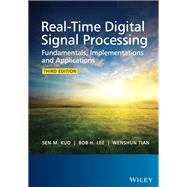Combines both the DSP principles and real-time implementations and applications, and now updated with the new eZdsp USB Stick, which is very low cost, portable and widely employed at many DSP labs.
Real-Time Digital Signal Processing introduces fundamental digital signal processing (DSP) principles and will be updated to include the latest DSP applications, introduce new software development tools and adjust the software design process to reflect the latest advances in the field. In the 3rd edition of the book, the key aspect of hands-on experiments will be enhanced to make the DSP principles more interesting and directly interact with the real-world applications. All of the programs will be carefully updated using the most recent version of software development tools and the new TMS320VC5505 eZdsp USB Stick for real-time experiments. Due to its lower cost and portability, the new software and hardware tools are now widely used in university labs and in commercial industrial companies to replace the older and more expensive generation. The new edition will have a renewed focus on real-time applications and will offer step-by-step hands-on experiments for a complete design cycle starting from floating-point C language program to fixed-point C implementation, code optimization using INTRINSICS, and mixed C-and-assembly programming on fixed-point DSP processors. This new methodology enables readers to concentrate on learning DSP fundamentals and innovative applications by relaxing the intensive programming efforts, namely, the traditional DSP assembly coding efforts. The book is organized into two parts; Part One introduces the digital signal processing principles and theories, and Part Two focuses on practical applications. The topics for the applications are the extensions of the theories in Part One with an emphasis placed on the hands-on experiments, systematic design and implementation approaches. The applications provided in the book are carefully chosen to reflect current advances of DSP that are of most relevance for the intended readership.
- Combines both the DSP principles and real-time implementations and applications using the new eZdsp USB Stick, which is very low cost, portable and widely employed at many DSP labs is now used in the new edition
- Places renewed emphasis on C-code experiments and reduces the exercises using assembly coding; effective use of C programming, fixed-point C code and INTRINSICS will become the main focus of the new edition.
- Updates to application areas to reflect latest advances such as speech coding techniques used for next generation networks (NGN), audio coding with surrounding sound, wideband speech codec (ITU G.722.2 Standard), fingerprint for image processing, and biomedical signal processing examples.
- Contains new addition of several projects that can be used as semester projects; as well as new many new real-time experiments using TI’s binary libraries – the experiments are prepared with flexible interface and modular for readers to adapt and modify to create other useful applications from the provided basic programs.
- Consists of more MATLAB experiments, such as filter design, algorithm evaluation, proto-typing for C-code architecture, and simulations to aid readers to learn DSP fundamentals.
Includes supplementary material of program and data files for examples, applications, and experiments hosted on a companion website.
A valuable resource for Postgraduate students enrolled on DSP courses focused on DSP implementation & applications as well as Senior undergraduates studying DSP; engineers and programmers who need to learn and use DSP principles and development tools for their projects.









